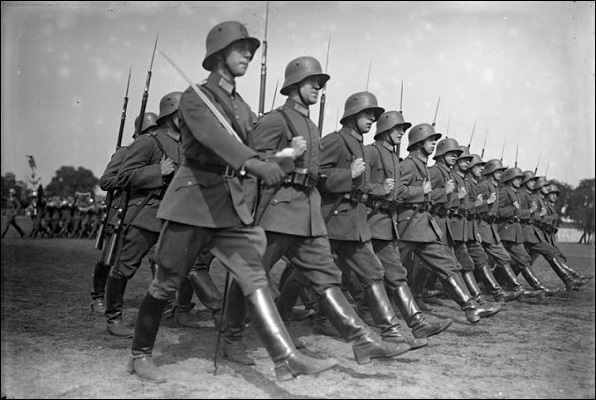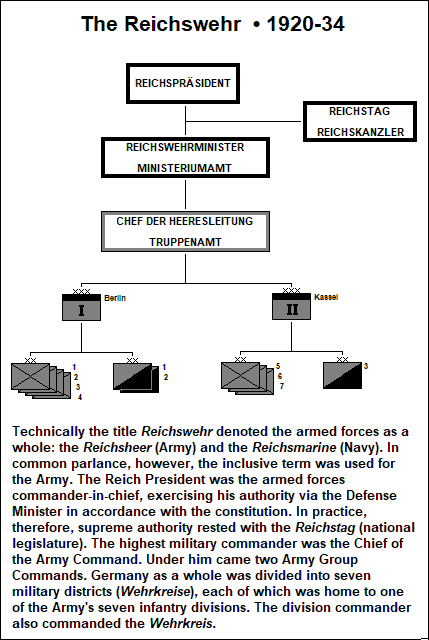|
● ● ●
After the end of the Great War, Germany was
compelled by the victorious Allies rapidly to demobilize its
Army. On 11 November
1918 it numbered well over 4 million men; a year later it was down
to 300,000. Under the terms of the Armistice vast quantities of
munitions, weapons and aircraft had to be handed over to the
victorious Allies, and it soon became obvious that they intended for
Germany to be substantially disarmed.
The 1919 Treaty of Versailles
formalized this intention. The Treaty stipulated that the German
Army of the Weimar Republic should consist of no more than 100,000 men: 4,000 officers and
86,000 other ranks. All were to be long-service professional
soldiers; conscription and short service were banned so as to
prevent the buildup of a trained military reserve. The Großgeneralstab (Great General Staff) and the
Kriegsakademie
(War Academy), the traditional intellectual centers of the German
Army, were abolished. As for weapons, the Peace Treaty permitted
Germany to keep no more than 105 armored cars, 204 77mm field guns,
84 105mm light field howitzers, 252 mortars, some 2,000 machine guns
and about 100,000 rifles and carbines—barely enough to arm the
Army’s seven infantry and
three cavalry divisions. Heavy artillery, tanks, frontier
fortifications and military aircraft were all prohibited. In this
form the new German Army, called the Reichswehr, was
organized in 1920 and officially established in January 1921.
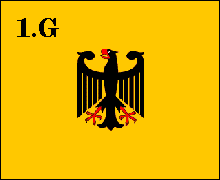
Command Flag of Reichwehr-Gruppenkommando 1 (Berlin)
But from the day of its founding the
Reichswehr—it
must be said with the connivance of the German government—employed
every possible subterfuge to evade the disarmament provisions of the
Peace Treaty. The actual military budget was always higher than officially admitted: twice as high between 1924 and
1928. This enabled the
Reichswehr
to acquire and stockpile three times as many rifles and six times as
many machine guns as were permitted to it by the terms of the
Versailles Treaty, along with substantial
additional quantities of mortars, field guns and field howitzers.
The German Transport Ministry subsidized clandestine military
aircraft development and aircrew training, while German industrial firms like Krupp carried
out covert research and
development work on tanks and heavy artillery
The
Treaty's manpower restrictions were also circumvented in various ways.
Many officers and soldiers who could not be employed on military
duties went into the
Grenzshutzpolizei
(Border Police) and the police forces of the German federal states,
which were organized along paramilitary lines. There was
also the so-called Black
Reichswehr:
frankly illegal military formations maintained under a variety of
cover designations, e.g. the “labor battalions” comprising some
18,000 men that were set up in Prussia under
Reichswehr
auspices. Many of their men came from the
Freikorps, the unofficial
volunteer military units that had sprung up in 1918-19 to defend
Germany’s eastern borders against Polish encroachment. The
Freikorps consisted mostly
of Great War veterans and came to play a major role in radical
right-wing politics, the most notorious example being the
participation of
Marinebrigade Ehrhardt
in the unsuccessful 1920
Kapp Putsch. Nonetheless, the Reichswehr
looked upon the
Freikorps
as a de facto military reserve and supported them with
arms and training.
By these means a modest increase in the size of the
Reichswehr
could be accomplished in the event of an emergency.
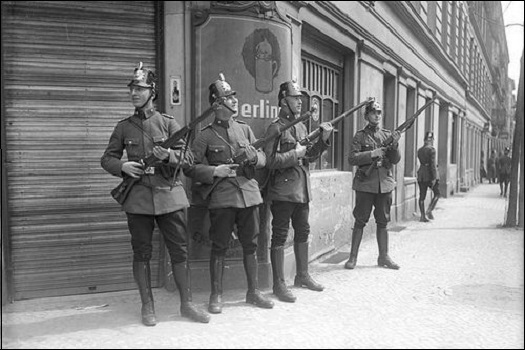
Men of the Prussian State Police in Berlin, 1929.
(Bundesarchiv)
Diplomacy also played an important role in clandestine rearmament.
In April 1922 Germany and the USSR concluded the Treaty of Rapallo, and
subsequently the
Reichswehr
set up a number of secret testing and training facilities in the
Soviet Union. These included a tank training establishment at Kazan
and an air force training base at Lipetsk. German industrial firms
also set up shop in the Soviet Union, where military R&D work could
be conducted far from prying eyes. In return for providing these
facilities, the USSR gained access to German military
technology. Farther afield, Gustav Stresemann, who served as Foreign
Secretary and Chancellor and between 1923 and 1929, worked
assiduously to establish contacts in countries including Sweden and
the Netherlands, where work on banned weapons could be carried out.
The effective commander of the
Reichwehr
was the Chef der Heeresleitung (Chief of the Army
Command). The first man to hold this title was General Hans von
Seeckt, a Prussian aristocrat and General Staff officer who’d made
his name on the Eastern Front during the Great War. After the
November 1918 armistice he was appointed to the committee charged
with the organization of the Weimar Republic’s peacetime army, and
it was he who gave the Reichswehr its final form.
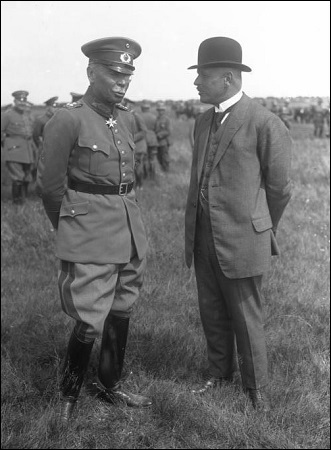
General Hans von Seeckt and Defense Minister Otto
Gessler in conversation during the 1925 maneuvers (Bundesarchiv)
From the beginning Seeckt
regarded the Reichswehr as a basis for a
major military
buildup when the time came, as almost all Germans
hoped it would, for the shackles of the Treaty of Versailles to be
struck off. To that end he ensured that only the best officers
and men were selected for the 100,000-man army. And though the
Great
General Staff was no more, its spirit lived on in the
Truppenamt
(Troops Office), which performed the staff functions essential to
any military force. Seeckt was also determined to keep the Army
clear of politics. Like many officers his outlook was authoritarian
and he merely tolerated the Weimar Republic. He laid down that the
Army was the guardian of the German nation in the most general
sense, not the servant of any particular regime or constitution.
Seeckt believed that the
restoration of German power depended on the establishment and
maintenance of good relations with Russia. Unlike most other
German conservatives, he had no fear of Bolshevism. Predictions of
the Red Army's arrival on the Elbe or even the Rhine he dismissed as
"fairy tales to frighten little children." His 1922 memorandum to
Count Ulrich von
Brockdorff-Rantzau, a former foreign minister who had just been
appointed Ambassador to the Soviet Union, was remarkably prescient:
With Poland we come now to the
core of the Eastern problem. The existence of Poland is
intolerable and incompatible with Germany's vital
interests. She must disappear and will do so through her
own inner weakness and through Russia — with our help.
Poland is more intolerable for Russia than for
ourselves; Russia can never tolerate Poland. With Poland's
collapse one of the strongest pillars of the Peace of
Versailles, France's advance post of power, is lost. The
attainment of this objective must be one of the firmest
guiding principles of German policy, as it is capable of
achievement—but only through Russia or with her help.
Poland can never offer Germany any
advantage, either economically, because she is incapable
of development, or politically, because she is a vassal
state of France. The restoration of the frontier between
Russia and Germany is a necessary condition before both
sides can become strong. The 1914 frontier between
Russia and Germany should be the basis of any
understanding between the two countries...
Here was prefigured the policy
that Hitler would follow from 1939 to 1941—which in the short term
did indeed produce the situation that Seeckt envisioned.
Ironically, a minor political misstep compelled Seeckt to retire in
1926, but by then his stamp had deeply impressed itself on the
Reichswehr.
His practical work provided a basis for rapid expansion when
Hitler embarked upon his rearmament program—and the
aloofness from politics that he had nurtured among the officer corps was to have parlous
consequences for both the Army and the nation it served.
● ● ●
|
